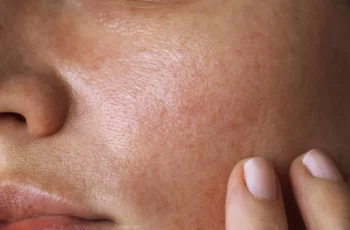
Can You Use Too Much Salicylic Acid?
Salicylic acid, the skin ingredient that has acne quaking in its boots. It’s no wonder it’s a favourite amongst dermatologists and skincare fans. One of the most used beta hydroxy acid, BHA, it can work far into the pores, clearing them of excess sebum, bacteria, dirt, and debris that can develop into all manner of skin concerns, such as blackheads, whiteheads, and spots. You’ll find that due to the fact it’s oil soluble and has a smaller molecular size of salicylic acid it penetrates further than other favourite actives, such as glycolic acid. This is highly effective at cleansing a skin type that is oily and prone to frequent breakouts but can have a common side effect of dryness and irritation. Before we dive into today’s blog post, let’s have a quick recap of the benefits of salicylic acid and how it benefits the skin.
How can salicylic acid benefit the skin?
Loosens the bonds between dead skin cells making them easily removed from the top layer of skin, revealing vibrant, fresh skin underneath.
Clears clogged pores and congestion in the skin by penetrating deep into the lower layers of skin.
Helps to regulate sebum production and secretion making skin more manageable.
Helps to reduce inflammation and signs of redness, resulting in active, large spots improving in appearance.
Combats blemishes and breakouts, such as whiteheads, blackheads, and spots.
Chemically exfoliates the skin surface and breaks down keratin which is found in the upper surface of the skin.
If you wanted to know even more about this clever powerhouse, check out our dedicated blog post about salicylic acid and its skincare benefits.
Is it bad to use salicylic acid every day?
Not really, but only if you use it correctly. By this I mean that due to salicylic acid being a highly potent ingredient, it can often have some drying side effects.
As I have mentioned previously, the structure of the acid being oil soluble and having a smaller molecular size results in it penetrating deeply into the pores. This is hugely effective for those who have an oily skin type and prone to frequent breakouts and acne. If, however, your skin type is dry and sensitive, applying salicylic acid to the skin too often will lead to several problems. Not only will it be too irritating on the skin, but it’ll also strip the skin barrier of the essential oil and water. This will have a knock-on effect as your skin will feel it needs to produce more sebum which can result in a flare-up of breakouts and spots. This cycle will begin to feel endless if you continue to use the wrong formulas for your skin, therefore I always recommend you perform a patch test for 24 hours before applying anything on your face. This will help determine how happy your skin is with the potency of the product.
Don’t forget, if you ever have any concerns with using a product, seek the advice of a doctor or dermatologists. This should give you peace of mind and reassurance you won’t cause any further damage or irritation to the skin.
How do you know if you’re using too much salicylic acid?
There are a few tell-tale signs that your skin has been exposed to too many acids. This could be a result of layering too many acids on the skin incorrectly or using a formula that is too potent. Here are some examples of some of the signs your skin has experienced overexposure to salicylic acid.
Dryness
You may find your skin type is more on the dry side, which is why it’s important to use acids with caution. Many find salicylic acid to be too harsh for the skin if they have a dry skin type, and decide to opt for other acids, such as lactic acid or a poly hydroxy acid, also known as PHA. These have a larger molecular size and are unable to penetrate as far into the skin as salicylic acid but can provide light exfoliation to the top layers and build-up of dead skin cells.
If you have started using a salicylic acid formula you may find the skin can feel tight, uncomfortable, and dry. You may have to go to the extent of pulling funny faces as the need to stretch the skin is overwhelming.
Irritation
This is the most common sign your skin is overexposed to acids. Some may find their skin is itchy, others may notice areas of redness, flaky patches of skin, and even painful to touch. If you experience any of these, even in the mildest state, stop using your product containing salicylic acid and seek the help of a dermatologist.
Breakouts and Acne Flare-Ups
As I have already mentioned, if you are using a formula that is too harsh for the skin you will find the lipid barrier is stripped of the vital oil and water needed to remain healthy. With the skin lacking this it will kick start an overproduction of sebum which will build-up on the skin surface and clog the pores resulting in blackheads, whiteheads, and other breakouts.
If you have found yourself suffering from any of the above, it could be time to have break and rethink about your skincare routine. The usual trap many fall into is thinking they need the most potent formula to get the best exfoliation. This isn’t the case and will cause you more trouble than benefits. Take some time to explore your skin and gain a better understanding of its type and the ingredients it adores.
Can too much salicylic acid cause acne?
Yes, if you find that once you have started using a new product containing salicylic acid results in you having acne, the BHA could be contributing to this. There are two reasons this will affect your skin, for example, it could be a result of the formula working in the lower layers and unclogging the pores of dirt, excess sebum, bacteria, and other impurities. You’ll often find all this “gunk” is pushed to the surface and appear as acne. This is very common and regularly occurs around the 4-week mark of using your new product. Skincare experts tend to call this skin purging and it slowly begins to subside after 6 weeks.
The other reason your salicylic acid can cause acne is due to the reason I have previously mentioned, and the skin barrier has been stripped of its water and oil. This weakens the barrier allowing exposure to free radicals penetrating the skin and causing spots, as well as the overproduction of sebum leading to acne flare-ups.
There you have some answers to some of the questions we have received recently about using too much salicylic acid. If you have any further questions, come, and find us on Instagram, we love hearing from you!


